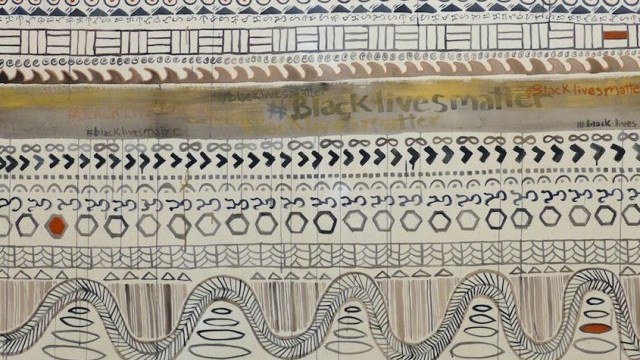Hashtags. Emojis. Tattooed sleeves. These are everyday images in the the 21st century. But images of a Turkish toddler’s body washed up on a beach and black citizens being beaten by cops have also flooded our daily lives. What happens when an artist ties in all of these images into one?
Washington D.C.-based artist Isabel Manalo opened her recent collection of work, “Skin Codes,” to Long Island’s community Nov. 7. She then gave a talk on her paintings on Nov. 18. The exhibition, showcased in Stony Brook University&'s Paul W. Zuccaire Gallery “addresses ideas of power and identity as defined by race, ethnicity, geography and class,” according to the gallery’s website.
Inspired by her Filipino heritage, Manalo displays these issues through the visual clues and coding of traditional pre-colonial Filipino tattooing.
She gives specific focus to the Syrian refugee crisis as well as racially charged police brutality. In order to fully incorporate her perspectives and relate to her audience, Manalo uses trends in social media, such as hashtags and emojis. In one of the works, Manalo paints “#Blacklivesmatter” in an array of color and sizes across the center of the canvas.
“I think it’s really important for an artist to, in order to be relevant, to address things that are happening,” said Rebecca Uliasz, a graduate student at Stony Brook University. “I like that incorporation of the hashtags, kind of a nice way and a really recognizable way to tie that in. That was a good way to kind of connect to, like, a diverse audience and just a university audience of young people.”
Perhaps one of the most interesting aspects of this collection is the attention to materials and texture that Manalo gave to her work.
To give her audience the feeling of observing actual tattoos, Manalo relied mostly on typical tattoo colors, such as black, blue and red. She even played with the texture and color of her canvases. For a final affect, some painting were taken off of their stretchers and draped on the wall, creating a skin-feel.
“I really started to imagine the canvas as skin, and [I] started to pick out canvases that were skin-like,” Manalo said. “I also started to manipulate the texture of the canvas by washing in and making it softer, trying to think of different shades of skin as a brown person, black person. No one’s really like pure white.”
Manalo has been showcased all over the nation: New York, Washington D.C., Orlando, Baltimore, Chicago, Los Angeles, San Francisco, Seattle and Philadelphia. It has even reached overseas, showing in places like Berlin, Bulgaria, Kazakhstan and Nepal.
Now finding a temporary home at Stony Brook University, the issues these paintings address and the ways in which they address them can relate to many on this campus, where there is large percentage are international and African-Americanstudents.
“I think that it is very relevant at the moment,” said Karen Levitov, director of the Paul W. Zuccaire Gallery. “It’s relevant to us as a university that we’re part of teaching and learning about issues as well as to the greater community because these issues affect all of us. They might be happening in Europe or in another country or in Asia, but these are things that matter to all of us as human beings.”


